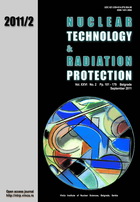
HEALTH RISK ASSESSMENT OF JOBS INVOLVING IONIZING RADIATION SOURCES

Vol. XXVI, No. 3, Pp. 181-274
December 2011
UDC 621.039+614.876:504.06 ISSN 1451-3994
Pages: 233-236
Authors: Vera D. Spasojević-Tišma, Dušica Č. Čeleketić, Jelena M. Tišma, Snežana B. Milačić, Gordana V. Papović-Đukić
AbstractThe study included 75 subjects exposed to low doses of external ionizing radiation and 25 subjects from the control group, all male. The first group (A) consisted of 25 subjects employed in the production of technetium, with an average job experience of 15 years. The second group (B) consisted of 25 subjects exposed to ionizing radiation from enclosed sources, working in jobs involving the control of X-ray devices and americium smoke detectors, their average work experience being 18.5 years. The third group (C) consisted of 25 subjects involved in the decontamination of the terrain at Borovac from radioactive rounds with depleted uranium left over after the NATO bombing of Serbia in 1999, their average job experience being 18.5 years. The control group (K) consisted of 25 subjects who have not been in contact with sources of ionizing radiation and who hold administrative positions. Frequencies of chromosome aberrations were determined in lymphocytes of peripheral blood and compared to the control group. The average annual absorbed dose determined by thermoluminescent dosimeters for all three groups did not exceed 2 mSv. In the present study, the largest number of observed changes are acentric fragments and chromosome breaks. The highest occupational risk appears to involve subjects working in manufacturing of the radioisotope technetium.
Key words: chromosome aberrations, ionizing radiation, human lymphocytes, occupational exposure
FULL PAPER IN PDF FORMAT ( 257 KB)